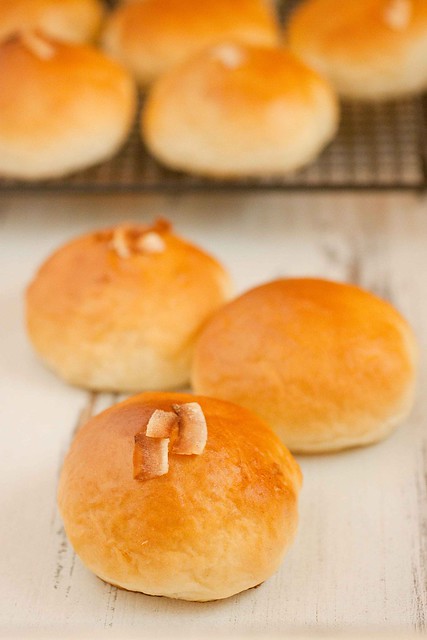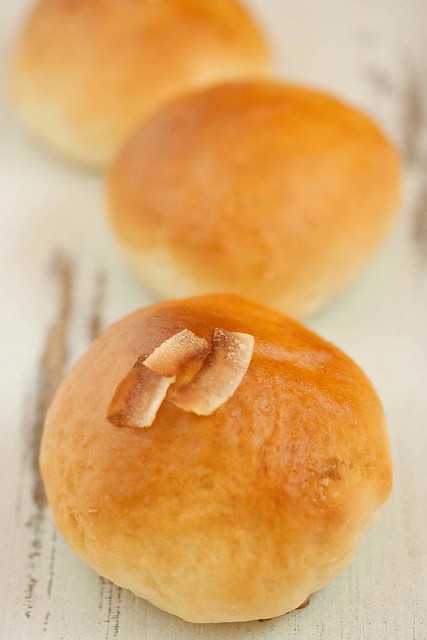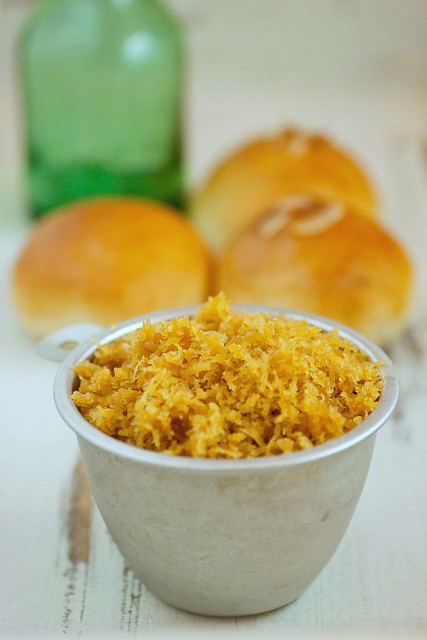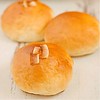




Last week, someone had asked me if I had tried any of the Tangzhong (water roux method) bread recipe from what has now become the 'tangzhong bread bible', 65C Tangzhong Bread by Yvonne C.
The sweet soft buns I had made earlier, uses a variation of the water roux.
Yvonne C's recipes are easy to follow. Although some may feel intimidated by the process of cooking the flour to precisely 65C, this is really not too difficult if you have a candy thermometer to help you monitor the temperature.
The water roux prepared this way is wetter and more watery than the my previous recipe. With so much moisture, I was looking forward to a softer and fluffier bread. However, unfortunately, the recipe calls for more flour (almost 30% more) and very little tebutter. The xture of these buns, although, still relatively soft, were much coarser and drier compared to my previous recipe. The only consolation is that the buns were wrinkle free. I do wonder, however, if I had not cooked the water roux correctly. I will try to repeat this again to confirm.
I have chosen to fill these buns with grated coconut cooked in palm sugar syrup. Together with red bean paste, the grated coconut filled bun has to be one of those local classic buns we grew up with. These can still be found in neighbourhood bakery stores - often sold in a 2x3 block. I don't think these old fashioned filled buns will ever go obsolete but as the younger generation becomes more spoilt for choices with BreadTalks' fancy flavours and the wide selection of western breads that are easily accessible to us today, these less stylish dough will most likely not stir up as much excitement as they did for us during our younger days. For me, I will gladly still eat them for breakfast every morning....
Recipe:
A.Tangzhong (Water roux)
Bread flour 50g
Water 250g
B.
Bread flour 210g
Plain flour 56g
Milk powder 20g
Castor sugar 42g
Salt 1/2 tsp
Yeast 6g
C.
Egg 1
Water 85g
Tangzhong 84g
D.
Unsalted butter 22g
Coconut Filling :
Grated coconut 250g
Gula Melaka 50g
Salt PinchPandan Leaves 4 pieces
Water 80g
Method :
1. Mix A together and cook over low heat until 65C - stirring all the time while cooking. When it is cooked, the mixture should look like starchy glue and you should be able to see the stirring lines in the dough. Remove from heat and cool down at room temperature.
2. Tie the Pandan leaves into a bit knot and boil it with gula melaka and water until gula melaka is completely dissolved. Remove the pandan leave and strain the syrup in to a heavy saucepan. Add grated coconut and cook until mixture is dry and fragrant.
3. Mix B with C in a mixing bowl and using a dough hook stir until mixture forms a dough. Add D and continue mixing at medium to high speed (about 15-20mins) until the dough is no longer tacky to touch. At this point, stretch the dough to check that it will not break easily ( window pane test).
4. Transfer dough into an oiled bowl, cover with plastic wrap and let it prove for 40mins.
5. Divide dough into small portions of 40g each. Roll each small portion into a smooth ball and all to prove for another 10mins.
6. Flatten each small ball and wrap with a tbsp of grated coconut filling. Seal the dough to form a ball again.
7. Let the buns prove for another 40 mins.
8. Brush with egg solution and bake at 175C for 15mins until golden brown.


你的面包
ReplyDelete比外面卖的还赞
看了好想吃:)
Thanks for sharing the coconut filling recipe. I'm gonna do some of these retro buns soon :)
ReplyDeleteYou're getting really good at the tangzhong method. These buns look good enough to sell! :)
ReplyDeletewhen i was a kid, i ate this coconut bun a lot..
ReplyDeleteI used to think I'm much younger than you, but it seems that lately the treats you post from your childhood days are from my childhood as well! I remember liking these coconut buns together with the red bean ones, as well as those coconut tarts (not sure what they're called).
ReplyDeleteI find that your previous method might produce softer bread because of the extended proofing time. I find that using the tangzhong method and using a protracted proofing time in the fridge (I put it overnight to proof) gives me bread with the softest texture so far. I'm interested in the results of your second attempt though and will be stalking you to find out! :)
Janine: Great idea! I think you've hit the nail on the head - I shall trying proofing it in the fridge next time!
ReplyDeletesoft delicious buns we make similar filling for crepe looks wonderful
ReplyDeleteOh Shirley! This looks fantastic and I am also looking forward to your other attempts.
ReplyDeletecoconut filling sounds so tasty!! and these buns looks delicious. I could have one right now!
ReplyDeleteI agree with Janine too. In general bread baking, longer and milder proofing method always produces better flavored and textured bread. I must try this for myself one day and stuff them with some sambal ikan bilis.
ReplyDeleteYour buns look so good! I love the look of that filling!! I always use the tangzhong method - I think my thermometer is a bit slow at responding to temperature changes though, so my roux is always too dry(I think)....haha :D But I always get really soft buns using this method anyway!
ReplyDeleteHmm, if you say so, then I still prefer your "Yukone" method! I love that recipe to bits!! Then I shall not attempt this. :p
ReplyDeleteHowever, I still must comment that your buns looked really pretty. :)
Shirley, I tried this yesterday. Pretty easy recipe and it rose nicely. I think if short of time for that overnight "resting", this recipe works fine when you only have 3 hours which I done this under 2.
ReplyDeleteThanks for sharing.
I love the buns! They look so inviting. *slurp*
ReplyDeleteYeah, I remember the days when I used to buy these type of buns from the breadman, so delicious! Your photos look very inviting!
ReplyDeleteYou can really see how soft and delicious these would be! Ahh I haven't had one in ages!
ReplyDeleteDo u know this is one of the buns i've been wanting to make since the day i learned how to make bread? LOL. Till today, i still haven't made them! Yours look irresistible!
ReplyDeleteAnd kudos to you, finally trying the tangzhong method ;)
I think first read about tangzhong method from one of our blogger friends but can't recall who. It has been ages since I have tasted one good coconut buns. I have bookmarked this to try. Thanks Shirley for sharing this recipe with us.
ReplyDeleteHallo,
ReplyDeleteIts my 1st time to your blog. Coincidentally, I am also thinking of making coconut buns the next few days.
I do have a copy of the book 65C Tangzhong Bread by Yvonne C, as well as Magic Bread by Alex Goh. Both books have a recipe for this coconut bun. So far I have only tried the sweet bread dough by Alex Goh since I bought that book first.
Your coconut buns look very tempting so I might give the Yvonne C's Tangzhong method a try :)
cheers
Bee
I only just made a bread with a water roux (recipe by Alex Goh), but I've not tried this particular method. Will be interested to see what happens when you try next time? Good to know though in the meantime you prefer your previous method.
ReplyDeletei've heard a lot about this tang zhong method! I'm really intrigued! my mum loves this kind of super soft buns!
ReplyDeleteLooks like you are on a "bread-roll". I just posted in your Hokkaido post and spied this post too! Definitely on my to-do list as I love coconut buns.
ReplyDelete